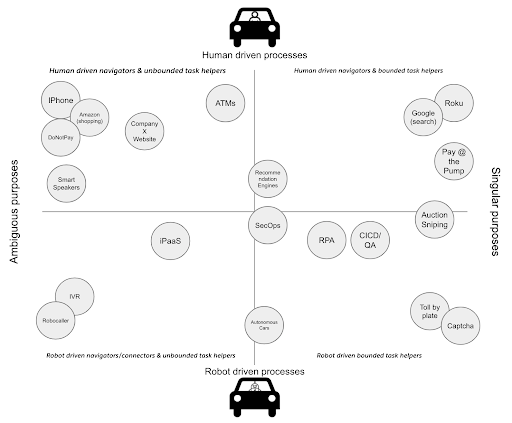In part one of this post, we took a historical look at efforts to drive transformations via automation, along with a four-step strategy to overcome human-based friction that slows down adoption. In part two, we’ll go deep on the automation efforts and challenges of today, setting up guideposts for advanced automation techniques across the full slate of automation opportunities.
Automation rules to align the wise and the stubborn
As organizations provision and execute automation initiatives, it is critical to have frame of reference to orient teams on what is possible and guide the efforts based on their larger context:
- Pick the easily automatable tasks aligned to enterprise goals (ripe fruit).
- Avoid the automations that are of questionable value and hurt stakeholder sentiment (bitter fruit).
One way to derive a frame of reference on automation opportunities is to view the landscape segmented by how much control humans will have and the complexity of the use cases the automation is expected to solve. IVR (interactive voice response) technology, for example, is a robot-driven processes automation tool — where the robot has almost completely removed the human from the driver seat of the process. The human can give-up/hang-up and some organizations have made it so the human can take back control via NLP (natural language processing) or “call me back” technology.
At the other end of the process-control spectrum is “DoNotPay,” a clever set of fully-automated offerings designed to push back against large organizations and institutions that force people into bureaucratic mazes with no way to opt-out. If the institution doesn’t allow for “call me back,” DoNotPay’s robot will sit on hold for you. If you have to engage in a time-sensitive process for service cancellation, DoNotPay’s robot will take care of that for you before you are charged.

Figure 3 – Automation Opportunity Landscape
This type of model gives strategy and implementation teams the opportunity to align their work with sage advice from McKinsey (referenced in part 1 of this post) — “the real gains from automation comes from rethinking how your business operates, not just applying technology to today’s processes.”
In the above landscape, each quadrant can be segmented to define its value proposition along with a set of best practices (enumerated clockwise, starting at the top left) that identify concepts to embrace and pitfalls to avoid:
#1 Human-driven navigators and unbounded task helpers:
Automation efforts in this zone save people time and energy on tasks whose boundaries are a bit more fluid (find, select, and purchase a gift, ask Siri or Alexa to execute a command, etc.). The practices to embrace and avoid are as follows:
- Embrace a broad array of revenue generating opportunities: This zone is rich in opportunities to create and drive revenue via consumer transactions, fees for transactions, and/or affiliate marketing.
- Avoid overlooking audience building and security concerns that make the offering viable: Opportunities in this zone require authenticated users to achieve scalable revenue. Having a plan and roadmap for acquiring customers and ensuring their privacy/security is maintained is a must have scope item in this zone.
#2 Human-driven navigators and bounded task helpers:
Automation efforts in this zone save people time and energy on crisply defined tasks (find and stream media content, pay for gas going into the store, etc.) The practices to embrace and avoid within this quadrant are:
- Embrace targeted opportunities for revenue: As we shift to automations that can act in more ambiguous circumstances, this zone has opportunities to drive revenue via consumer transactions. Additional possibilities are unlocked as this technology provides “next right step” or up-sell/cross-sell opportunities.
- Avoid underestimating user expectations that drive the value promise: Opportunities in this zone require highly optimized interactions as users have a concrete and well-defined task in mind. Information retrieval in a search context is mature enough to qualify as a bounded task. If the path to a user outcome is not optimized, customers switch paths quickly as an alternative offering is likely more readily available.
#3 Robot-driven navigators/connectors unbounded task helpers:
This zone is targeted to help organizations save scaled labor expenses (automating a call center via IVR) where the robot connects a set of stakeholders to address a concern (contest a charge on a credit card, adjust travel reservations, etc.) The practices to embrace and avoid are as follows:
- Embrace giving humans more control: When robots engage humans as objects rather than people, you can safely assume that humans will be dissatisfied and will do everything they can to escape the robot queue (pressing 0 repeatedly to force the IVR to transfer you to a human).
One area to focus on here is to refine automated capabilities that can help to optimize stakeholder engagement like enabling “call me back” options to avoid long hold times and or using natural language processing (NLP) to bypass robot monologues. These types of automation features help to put humans in the driver’s seat and are critical to achieve the cost optimizations without negatively impacting your brand and consumer sentiment.
- Avoid automating interactions without improved quality of product/service: If the benefit of the automation is focused solely on reducing costs and has no positive impact on the quality of the product or service, it will likely not be embraced by your audiences. The more premium your offering or service is, the more you should question whether this type of automation will result in positive outcomes for your organization.
#4 Robot-driven bounded task helpers:
Automation efforts in this zone help people and organizations reduce the frequency of process errors and the costs to remediate them. As errors go down, predictability and overall system flow and quality improves (automate the build and deployment processes for an app, simple RPA deployments, etc). Specific practices to align around within this quadrant are:
- Embrace improving safety and quality: Utilizing automated processes and robots to systematize frequently used manual processes and reduce error frequency is critical for achieving positive outcomes in this zone. Many organizations haven’t fully accounted for the cost of identifying and remediating errors as the cost of each specific error can range wildly based upon timing and context. Teams and processes that are organized for iterative process completion need these types of automation to achieve predictable, positive outcomes.
One aspect to pay attention to in this zone’s automation efforts is to align your robot designers and builders with the concept that “continuously unlocking context” is needed to improve precision on decision making. When the cost of failure is sufficiently high, it’s not enough to be incrementally better than a human decision maker. In high stakes contexts, showing your path to widening the gap between robot and human decision makers is often necessary to allay the concerns of robotic failure which can scale much further and faster than the mistakes of an isolated human individual.
- Avoid overlooking error cases that scuttle the value promise: One factor to be aware of in this quadrant is that giving humans more control isn’t necessarily a desired goal of the automation efforts. In this quadrant, finding ways to help the human trust the process in question (continuous delivery without human interaction, safe self-driving cars, non-interactive toll collection, etc.) is the desired outcome.
Efforts in this zone must take a key concept into consideration: the only way to arrive at a sufficiently high level of confidence in the robot driving the process is an unrelenting focus on the error cases and outliers that the robot must be able to address. Much like the way “chaos engineering” has led to higher levels of resiliency, automations can reach appliance-like levels of human confidence when “last mile” topics have been surfaced and accounted for.
Manufacturing the robot-human alliance via shared advantage
If we take all of this into consideration, a new strategic concept emerges for ensuring the success and acceptance of automating the business — source automation targets with near-term human concerns on par with long-term business ones.
For example:
- Do Not Pay’s offering is exploiting the lack of balance (within some enterprises) between human concerns and business concerns.
- RPA’s value proposition is grounded not in reinventing work roles, but instead in automating tasks that would otherwise drown workers in tedious and repetitive work with little visible impact.
- iPaaS offerings, like Anypoint Platform, focusing on making integration teams more impactful and visible to enterprises.
- Recommendation and other “next right step” engines help businesses and humans be more successful with their current tasks.
This model aligns with a long-standing best practice for achieving complex change within an enterprise: envision the change outside-in (long-term business leadership goals) and build the change inside-out (near-term human contributor goals).
A specific benefit of this particular guidepost is that it can give a C4E (Center for Enablement) something to drive it’s work beyond establishing system APIs and reference architectures. The automation strategy above can empower your C4E to pave the path towards future business outcomes that are co-created and co-governed by a team that leverages “automation assisted” capabilities targeted at the individual contributors.
If transformation leaders can balance the needs that span their ecosystems, maybe this time, we’ll be able to transcend Jevons and workers around the world will greet their robot helpers with open arms.
To learn more about the role of automation in the modern enterprise, download our CIO guide to enabling business automation eBook.









